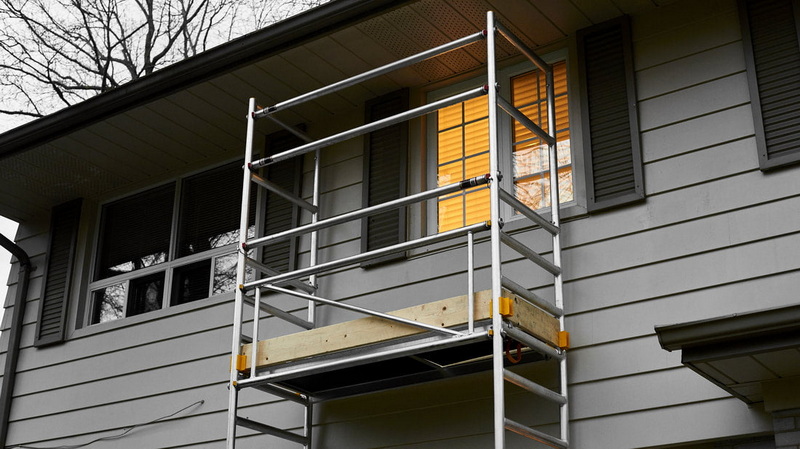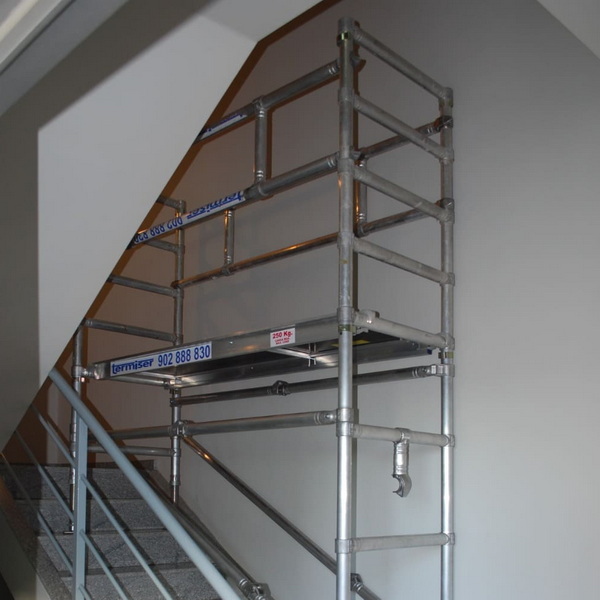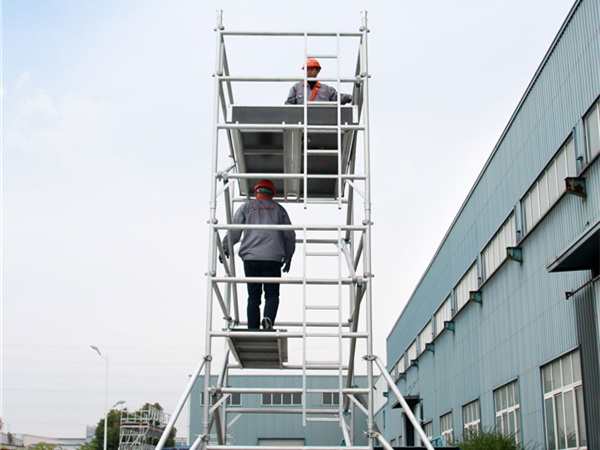Content Menu
● What Is Aluminum Painters Scaffolding?
● Key Features of Aluminum Painters Scaffolding
● Why Choose Aluminum Painters Scaffolding for Painting Jobs?
>> Superior Stability and Safety Compared to Ladders
>> Lightweight and Portable
>> Corrosion Resistance for Longevity
>> Versatility for Various Painting Projects
● Safety Considerations and Best Practices
>> Follow Manufacturer's Instructions
>> Inspect for Loose or Damaged Parts
>> Ensure Level and Solid Ground
>> Use Guardrails and Toe Boards
>> Secure the Scaffold
>> Limit Loads and Avoid Overcrowding
>> Use Personal Protective Equipment (PPE)
● Step-by-Step Assembly of Aluminum Painters Scaffolding
● Comparison: Aluminum Scaffolding vs. Other Types for Painting
● Common Concerns About Aluminum Painters Scaffolding
>> Is Aluminum Strong Enough for Heavy Loads?
>> Does Aluminum Scaffolding Rust or Corrode?
>> Can Aluminum Scaffolding Be Used Indoors?
>> How Does Aluminum Scaffolding Compare Cost-Wise?
● Conclusion
● FAQ
>> 1. Is aluminum painters scaffolding safe for use at heights above 10 feet?
>> 2. How does aluminum scaffolding compare to steel scaffolding for painting jobs?
>> 3. What safety precautions should be taken when using aluminum painters scaffolding?
>> 4. Can aluminum painters scaffolding be used on uneven ground?
>> 5. How often should aluminum scaffolding be inspected?
● Citations:
When it comes to painting projects, especially those involving heights, safety and reliability are paramount. Aluminum painters scaffolding has become increasingly popular due to its lightweight, corrosion resistance, and ease of assembly. But is it truly safe and reliable for painting jobs? This comprehensive article explores the safety features, benefits, common concerns, and best practices related to aluminum scaffolding in painting applications, supported by images and videos to provide a clear understanding.

What Is Aluminum Painters Scaffolding?
Aluminum painters scaffolding is a temporary elevated platform made primarily of aluminum, designed to provide painters with a stable and secure working surface. Unlike traditional steel or wooden scaffolds, aluminum scaffolding is lighter, easier to transport, and resistant to rust and corrosion, making it ideal for both indoor and outdoor painting projects.
Key Features of Aluminum Painters Scaffolding
- Lightweight Design: Aluminum's low density makes the scaffolding easy to move and set up.
- Corrosion Resistance: Aluminum does not rust, which is especially beneficial for outdoor or humid environments.
- Durability: Despite its light weight, aluminum scaffolding is strong enough to support multiple workers and equipment.
- Ease of Assembly: Many aluminum scaffolding systems use snap-lock or cuplock mechanisms for quick and secure assembly.
- Safety Components: Guardrails, toe boards, and locking wheels are often included to enhance safety.
Why Choose Aluminum Painters Scaffolding for Painting Jobs?
Superior Stability and Safety Compared to Ladders
Unlike ladders, aluminum painters scaffolding provides a wide, stable platform that reduces the risk of falls. Guardrails and toe boards can be installed to prevent accidental slips. The ample space also allows painters to move freely and keep their tools within reach.
Lightweight and Portable
The lightweight nature of aluminum scaffolding means painters can easily transport and reposition the scaffold without heavy machinery or excessive labor, improving efficiency on the job site.
Corrosion Resistance for Longevity
Aluminum's natural resistance to corrosion means scaffolding remains structurally sound over time, even when exposed to moisture, paint solvents, or harsh weather conditions.
Versatility for Various Painting Projects
Aluminum scaffolding can be configured in multiple ways—single or multi-level platforms, mobile towers with wheels, or stationary setups—making it suitable for interior walls, ceilings, or exterior facades.
Safety Considerations and Best Practices
Follow Manufacturer's Instructions
Always assemble aluminum painters scaffolding according to the manufacturer's guidelines to ensure all components are correctly installed and locked.
Inspect for Loose or Damaged Parts
Before use, check for any loose bolts, damaged frames, or worn locking mechanisms. Tighten or replace parts as necessary.
Ensure Level and Solid Ground
Place scaffolding on flat, stable surfaces. Use adjustable base plates or leveling jacks to compensate for uneven ground.
Use Guardrails and Toe Boards
Install guardrails at the platform edges and toe boards to prevent tools or paint cans from falling.
Secure the Scaffold
When working at heights above 10 feet, use tie-in devices or heavy wire to anchor the scaffold to a fixed structure to prevent tipping.
Limit Loads and Avoid Overcrowding
Do not exceed the scaffold's rated load capacity. Limit the number of workers and materials on the platform to maintain stability.
Use Personal Protective Equipment (PPE)
Painters should wear hard hats, non-slip footwear, and harnesses if working at significant heights.

Step-by-Step Assembly of Aluminum Painters Scaffolding
1. Prepare the Site: Clear debris and level the ground.
2. Set Base Plates or Wheels: Position adjustable base plates or locking wheels.
3. Erect Vertical Frames: Connect vertical frames or standards.
4. Install Horizontal Ledgers: Lock horizontal ledgers into place using snap-lock or cuplock mechanisms.
5. Add Diagonal Bracing: Secure diagonal braces to prevent sway.
6. Place Scaffold Boards: Lay planks or platforms on transoms.
7. Install Guardrails and Toe Boards: Attach safety rails around the platform.
8. Perform Final Inspection: Check all connections and stability before use.
Comparison: Aluminum Scaffolding vs. Other Types for Painting
| Feature | Aluminum Painters Scaffolding | Steel Scaffolding | Wooden Scaffolding | Ladder |
| Weight | Lightweight | Heavy | Heavy | Lightweight |
| Corrosion Resistance | Excellent | Moderate | Poor | Poor |
| Portability | High | Moderate | Low | High |
| Assembly Speed | Fast | Moderate | Slow | Instant |
| Stability | High | Very High | Moderate | Low |
| Safety Features | Guardrails, locking wheels | Guardrails, locking wheels | Limited | None |
| Cost | Moderate | High | Low | Low |
Common Concerns About Aluminum Painters Scaffolding
Is Aluminum Strong Enough for Heavy Loads?
Yes. Aluminum scaffolding is engineered to support multiple workers and their equipment safely. However, it is essential to adhere to the rated load limits specified by the manufacturer.
Does Aluminum Scaffolding Rust or Corrode?
No. Aluminum naturally forms a protective oxide layer that prevents rust and corrosion, making it ideal for outdoor use.
Can Aluminum Scaffolding Be Used Indoors?
Absolutely. Its lightweight and non-corrosive nature make it suitable for indoor painting projects, especially in tight or delicate spaces.
How Does Aluminum Scaffolding Compare Cost-Wise?
While aluminum scaffolding may have a higher upfront cost than wood or ladders, its durability, ease of use, and safety features often result in cost savings over time.
Conclusion
Aluminum painters scaffolding is a safe, reliable, and efficient solution for painting jobs of all sizes. Its lightweight design, corrosion resistance, and robust safety features make it superior to ladders and many traditional scaffolding types. When properly assembled and used according to safety guidelines, aluminum scaffolding provides painters with a stable platform that enhances productivity and minimizes the risk of accidents. Whether for residential, commercial, or industrial painting projects, aluminum scaffolding is a smart investment that prioritizes worker safety and job efficiency.

FAQ
1. Is aluminum painters scaffolding safe for use at heights above 10 feet?
Yes. When equipped with guardrails, toe boards, and properly secured with tie-in devices, aluminum painters scaffolding is safe for use at heights above 10 feet[1][2].
2. How does aluminum scaffolding compare to steel scaffolding for painting jobs?
Aluminum scaffolding is lighter and more corrosion-resistant, making it easier to transport and ideal for humid environments. Steel scaffolding is heavier and stronger but can be prone to rust without proper maintenance[5][6].
3. What safety precautions should be taken when using aluminum painters scaffolding?
Follow manufacturer instructions, inspect components regularly, use guardrails and toe boards, secure scaffolding to fixed points, and wear appropriate PPE[1][2][4].
4. Can aluminum painters scaffolding be used on uneven ground?
Yes. Adjustable base plates or leveling jacks can be used to stabilize aluminum scaffolding on uneven surfaces[2].
5. How often should aluminum scaffolding be inspected?
Daily inspections before use and periodic maintenance checks are recommended to ensure structural integrity and safety[1][4].
Citations:
[1] https://msafegroup.com/your-guide-to-aluminium-scaffolding-safety-the-dos-donts/
[2] https://scaffoldtype.com/painters-scaffolding/
[3] https://www.mtandt.com/blogs/exploring-the-versatility-of-aluminium-scaffolding
[4] https://alufasescaffold.com/aluminum-scaffold-safety-guide/
[5] https://www.sparsteel.com/blog/steel-scaffolding-vs-aluminium-scaffolding-material-application-safety-cost/
[6] https://www.fommec.com/best-scaffolding-for-painting-jobs-2/
[7] https://www.k2scaffold.com/post/who-should-use-aluminium-scaffolding
[8] https://www.fommec.com/best-scaffolding-for-painting-jobs/






















